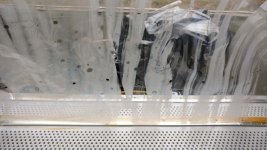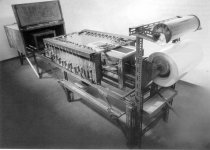Nice idea, but be prepared for long printing time: I made a model of a 57 panel from memory, cut down to 1/4 in length and got a result of 6 hours. The many holes is the culprit here..
If You have a speedy printer with large building area, and go ahead with printing, I have an idea for the conducting layer: Glue 3 very thin copper strips over the hole areas, on the outside. Place the stator on a flat surface and fill the 0.7 mm deep "bassins" with ferric chloride and etch away copper that covers the holes...
is using a router not faster with some PCB material ? or 3d printing since you got one ? in the quads i gues the holes where punched
i mean of course you work with what you got ! would love to see a 3d printed version of a panel
Looks familiar.To get up back on track, take a look at the haphazard application of the coating on this Quad Bass panel. It appears to be applied by a toddler using a string mop.
Sheldon
quadesl.com
Attachments
It seems the coating is just thrown on the mylar without using anything. Amazing.....
And when they were new they would fully charge up in about the same time the Quad II amplifier tubes would warm up. Now that coating takes a day or more to fully charge. It wasn't a good choice for a coating, and they moved away from it in the 63's and newer.
Sheldon
quadesl.com
So we now have 4 different coatings to further test on the ESL-63 and later on the ESL.
The first 2 coatings are graphite variations with one that holds 8-9% graphite particles of 3 micron. The second holds only 5% of the same graphite. The resistivity of these coatings can be influenced by changing the composition of the components from 10^5 - 10^13.
Third we have the Elvamide (nylon) coating (with very very high resistance 10^12 - 10^14). This one is original from the ESL, but can it be used on the 63?
All three of these coating add an average of 3 micron to the original 3 micron of the Mylar. The nylon adds the most weight.
Last but not least there is the PEDOT SS coating. This coating has a thickness of only nano meters, so adds no (measurable for me) weight and no thickness to the Mylar.
SS coating. This coating has a thickness of only nano meters, so adds no (measurable for me) weight and no thickness to the Mylar.
Now we're going to look which one
- holds the most charge
- has higher output
- sounds better
- is the most durable
etc.
The first 2 coatings are graphite variations with one that holds 8-9% graphite particles of 3 micron. The second holds only 5% of the same graphite. The resistivity of these coatings can be influenced by changing the composition of the components from 10^5 - 10^13.
Third we have the Elvamide (nylon) coating (with very very high resistance 10^12 - 10^14). This one is original from the ESL, but can it be used on the 63?
All three of these coating add an average of 3 micron to the original 3 micron of the Mylar. The nylon adds the most weight.
Last but not least there is the PEDOT
Now we're going to look which one
- holds the most charge
- has higher output
- sounds better
- is the most durable
etc.
So we now have 4 different coatings to further test on the ESL-63 and later on the ESL.
The first 2 coatings are graphite variations with one that holds 8-9% graphite particles of 3 micron. The second holds only 5% of the same graphite. The resistivity of these coatings can be influenced by changing the composition of the components from 10^5 - 10^13.
Third we have the Elvamide (nylon) coating (with very very high resistance 10^12 - 10^14). This one is original from the ESL, but can it be used on the 63?
All three of these coating add an average of 3 micron to the original 3 micron of the Mylar. The nylon adds the most weight.
Last but not least there is the PEDOTSS coating. This coating has a thickness of only nano meters, so adds no (measurable for me) weight and no thickness to the Mylar.
Now we're going to look which one
- holds the most charge
- has higher output
- sounds better
- is the most durable
etc.
I can promise you that the Elvamide isn't durable at all. When the original ESL's were new they charged in seconds, now they charge in many hours or days. If it were me, I wouldn't waste my time with it.
IF your coating is uniform and unbroken and a reasonable resistance, you shouldn't get a higher output from one vs the other. Output is a function of polarizing voltage and DS spacing of a panel.
Sheldon
quadesl.com
Last edited:
As BVG put it in another thread
"with contemporary materials things can be done way better than 50 years ago."
Elvamide price in near to nothing and it does not hurt to try. Putting some effort you may find
soluble polyamide in nearby shop. All you need it find the application it's used.
"with contemporary materials things can be done way better than 50 years ago."
Elvamide price in near to nothing and it does not hurt to try. Putting some effort you may find
soluble polyamide in nearby shop. All you need it find the application it's used.
Last edited:
A sure bet is Martin Dijkstra,s coating.
Worked perfectly for my 988,s
Regards
David
Hi David
What are you referring to ?
could you provide a link ?
..My cells…charge very slowly as indicated by SPL. They take perhaps 18 hrs to be within maybe 2dB of their final SPL. The increase is uniform across their band, roughly 40-15kHz. There is a substantial resistance, maybe 100 MOhms, not sure, in series with the HW power supply.
…what I would actually appreciate is learning what are the benefits and harms of having cells that seem to charge very slowly, perhaps due to very large series resistance or coating?
Certainly 100Mohms or even 10x that would not result in a charging time constant of 18hours. It seems most likely that the slow charge is due to very high coating resistance. The benefits are potentially lower distortion, especially at lower frequencies. The harm is that you may not have uniform charge distribution over a panel’s area, and it may never reach full charge…or be different for each panel in the group.
bentoronto was kind enough to send me a couple of his spare DW(Dayton Wright) panels to evaluate. At some point I need to finish up my measurements and post them along with dimensional specifications. One thing I noticed was that when the panels were charging the charge distribution on the diaphragm was not uniform. If I measured with microphone right at the stators, the response above 3kHz or so was present in some areas and completely absent from others. Typically, NF measurements do not vary much over the diaphragm area. This makes me think the coating has areas of differing conductivity. If I exhaled on the diaphragm, the panel quickly charged up and measurement was uniform over the full area.
A couple questions:
- Was the charge time this long (18hrs) when the panels were new?
- Is the charge time shorter/longer/same when air is humid vs. dry?
- Before the panels have completely charged up, have you ever measured the response right at the diaphragms to see if the response varies with position?
Many thanks for fielding my questions....A couple questions:
- Was the charge time this long (18hrs) when the panels were new?
- Is the charge time shorter/longer/same when air is humid vs. dry?
- Before the panels have completely charged up, have you ever measured the response right at the diaphragms to see if the response varies with position?
I've been using these cells for about 40 years with a DIY "interface". But for 25 years in the middle, they were in storage while I used DW speakers which have very bias voltage maybe 8kV. Moreover, I've haven't earlier been so compulsive about tracking how their output rises from zero in DIY version or factory. So I don't have reliable answers to your questions.
B.
Apart form the fact if it would work because of the extremely high resistance, like 10^12 and beyond and the challenge to dissolve it in a liquid. You would have a huge challenge applying it.Can anyone confirm whether elvamide can be used for coating on esl-63/98x panels ?
As you can see in previous posts it was already a challenge to apply it to the original ESL Mylar. On that diaphragm there are no initial holes and obstacles to work around, so you can apply by big straight strokes. Even then there were spots missed and spots hit double. On the 63 you can't apply in straight strokes because of the 3 fixation points. I have tried but haven't found a way to apply it evenly. For that reason I've not been able to test it further, because I can't get beyond this point.
I have seen that Quad used an oven for applying the Elvamide coating on the original ESL. Anyone any idea how they used the oven in the original ESL process? Photo kindly borrowed from Sheldon's website.
Attachments
I tried myself to apply dissolved Elvamide and coudn't do any better. Have you tried applying?To get up back on track, take a look at the haphazard application of the coating on this Quad Bass panel. It appears to be applied by a toddler using a string mop. Sheldon quadesl.com
Actually I tried it
I couldn't get a uniform layer on top until I used a hair dryer just blowing air (not hot)
I experimented on one Esl63 bass panel.
Noticed that the spl output was really low and the amplifier got very very very hot!
The only good thing is that the coating came of without destroying the mylar
I couldn't get a uniform layer on top until I used a hair dryer just blowing air (not hot)
I experimented on one Esl63 bass panel.
Noticed that the spl output was really low and the amplifier got very very very hot!
The only good thing is that the coating came of without destroying the mylar
Apart form the fact if it would work because of the extremely high resistance, like 10^12 and beyond and the challenge to dissolve it in a liquid. You would have a huge challenge applying it.
As you can see in previous posts it was already a challenge to apply it to the original ESL Mylar. On that diaphragm there are no initial holes and obstacles to work around, so you can apply by big straight strokes. Even then there were spots missed and spots hit double. On the 63 you can't apply in straight strokes because of the 3 fixation points. I have tried but haven't found a way to apply it evenly. For that reason I've not been able to test it further, because I can't get beyond this point.
I have seen that Quad used an oven for applying the Elvamide coating on the original ESL. Anyone any idea how they used the oven in the original ESL process? Photo kindly borrowed from Sheldon's website.
it would work because of the extremely high resistance, like 10^12 and beyond
This is too high for panels. IMO.
Difference between Anti-Static, Dissipative, Conductive, and Insulative
Surface resistivity needs to be 10^7/ 10^8.
- Home
- Loudspeakers
- Planars & Exotics
- ESL Diaphragm coating



